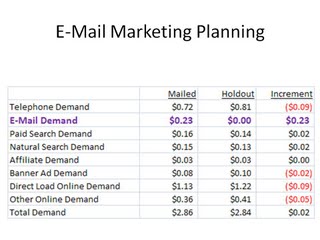Planning: E-Mail Marketing
Annual Sales Planning is a lost art. In E-Mail Marketing, Annual Sales Planning is an art that was never crafted!
Here's the problem. Traditional E-Mail Marketing metrics (open rates, click-through rates, conversion rates) only measure what a customer does during a small window of time. So if an E-Mail Marketing program is delivered on a Monday, causing a customer to buy on Monday, but causes the customer to skip a purchase that would have happened on Thursday, you miss the lost sale on Thursday --- you only record the positive, you never record the negative.
That, my friends, is a problem. It means that you significantly overstate the importance of e-mail marketing.
Marketers avoid this problem by analyzing the results of mail and holdout groups. For instance, say you have an e-mail marketing list of 1,000,000 users. In each e-mail campaign, you mail 80% of the list, and you hold out 20% of the list.
(At this point, folks in the e-mail marketing community can be heard shrieking, as this goes against all established best practices).
We want a huge holdout group so that we can accurately measure what impact e-mail marketing has on other micro-channels. Does e-mail marketing help or hurt search marketing, for instance? I'd want to know that, wouldn't you?
A typical mail/holdout result looks something like this:

This table represents the secret that is obscured by traditional e-mail marketing metrics (open rate, click-through rate, conversion rate). Look at Telephone Demand --- if you send an e-mail marketing campaign, then Telephone Demand decreases. This means that the e-mail marketing campaign caused some customers to change their behavior, switching previously planned telephone orders to the e-mail channel.
E-Mail marketing generates $0.23 of demand ... this is what would typically be measured by e-mail marketing programs.
Now look at Paid and Natural Search. There are small increases. This means that e-mail marketing causes a customer to go out and search for information. Your e-mail marketing program may actually cause an increase in the Paid Search budget. Don't you want to know that, and budget for that accordingly?
Notice that e-mail marketing cannibalizes ordinary online channels.
In this example, e-mail marketing is estimated to generate $0.23 demand per customer --- but in reality, it is truly generating $0.02 demand per customer.
This is a common outcome among online brands and catalog brands.
For retail brands, we often see the opposite outcome.

Often, in retail, we see that e-mail marketing generates MORE demand than is measured via typical e-mail marketing analytics. Classic e-mail marketing fails to capture all of the incremental retail volume driven by e-mail marketing.
I find it fascinating that e-mail marketers don't ever talk about this --- their marketing programs generate tons of retail volume that they don't ever get credit for, and e-mail marketers don't seem to care about this.
CARE!
The modern Executive knows exactly what happens to every channel when e-mail marketing is increased, or withheld. The modern Executive uses this information in Annual Sales Planning, knowing that the information gives the leader tremendous strategic latitude. The modern Executive is not a slave to "comping what was done last year".
Labels: Planning
1 Comments:
Kevin -
Great illustration of the unaccounted value (negative or positive) of email marketing. In my experience there are two major hurdles to a truer accounting of that value:
1. Convincing a retailer to hold out 20% of their mailable population. (You mean you want me to give up 20% revenue when I have to comp x% this month?)
2. For bricks and clicks retailers, accessing and correlating in-store activity with online behavior is a major hurdle. Again more costs that don't drive this year's comps.
Maybe next year!
Post a Comment
Links to this post:
Create a Link
<< Home